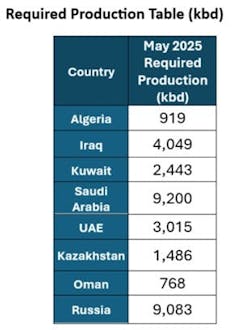OPEC+ accelerates oil supply hike amid tariff tensions
On Apr. 3, the OPEC+ alliance unexpectedly announced a larger-than-anticipated supply boost for May, triggering a market-wide reaction. The organization confirmed it would increase oil output by 411,000 b/d in May—a figure that consolidates 3 months' worth of planned hikes—following a ministerial conference focused on enforcing production discipline among member countries.
The market had generally expected a more modest increase of around 140,000 b/d for May, based on earlier agreements. The Ice Brent contract with June delivery fell below $70/bbl in Apr. 3 in response to the decision, down nearly 7% from the Wednesday close.
In its Thursday statement, OPEC indicated that the May output hike will “provide an opportunity for the participating countries to accelerate their compensation." OPEC+ officials said the decision also aims to maintain credibility in the group’s quota system amid a fragile global oil demand outlook.
The market reaction was intensified by broader macroeconomic concerns, including new US trade measures. On Apr. 2, US President Donald Trump unveiled sweeping new tariffs targeting key US trading partners. The administration imposed a 10% minimum tariff on all imported goods, coupled with country-specific reciprocal tariffs.
Trump revealed a chart announcing that the US would impose a 34% reciprocal tariff on imports from China. This new tariff is in addition to the existing duties on specific Chinese goods, such as automobiles, and the 20% tariff already set during his first administration. Moreover, a similar 20% tariff will also apply to products imported from the EU and other significant trading partners.
However, energy products—including oil and natural gas—were notably excluded from the new trade penalties. The White House confirmed that the existing tariff framework, introduced in March, would remain in place for Canada and Mexico. Under that system, USMCA (United States-Mexico-Canada Agreement)-compliant goods continue to receive 0% tariffs, while non-compliant goods face tariffs of up to 25%, depending on the category. Non-USMCA compliant energy and potash will see a 10% tariff.
"We welcome President Trump's decision to exclude oil and natural gas from new tariffs, underscoring the complexity of integrated global energy markets and the importance of America's role as a net energy exporter," said Mike Sommers, American Petroleum Institute (API) president and chief executive officer, in a statement. "We will continue working with the Trump administration on trade policies that support American energy dominance."
While energy may be spared for now, the ripple effects of rising trade barriers are likely to shape both global economic performance and the energy markets in the months ahead. Analysts warn that the escalating trade tensions could depress global economic growth and energy demand.
In a recent note, S&P Global Market Intelligence projected that an intensified trade war could cut global GDP growth by 1% and reduce oil and liquid fuels demand by about 500,000 b/d in 2025. Meantime, a new survey from Bloomberg Intelligence expects that Brent will sit below $70/bbl at year end, with the threat of new US tariffs and the potential for expanding trade wars skewing the price risk down.

Conglin Xu | Managing Editor-Economics
Conglin Xu, Managing Editor-Economics, covers worldwide oil and gas market developments and macroeconomic factors, conducts analytical economic and financial research, generates estimates and forecasts, and compiles production and reserves statistics for Oil & Gas Journal. She joined OGJ in 2012 as Senior Economics Editor.
Xu holds a PhD in International Economics from the University of California at Santa Cruz. She was a Short-term Consultant at the World Bank and Summer Intern at the International Monetary Fund.



